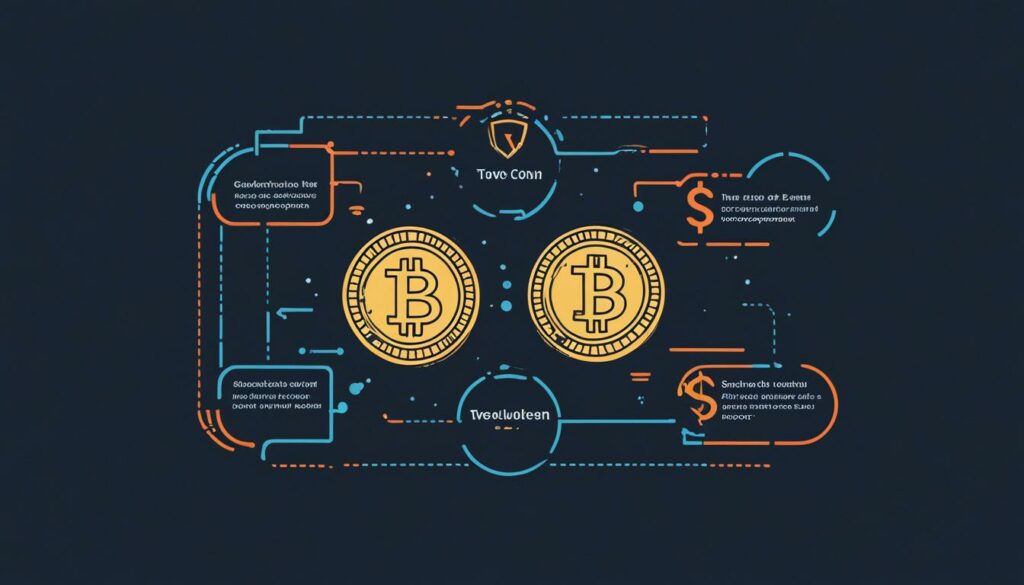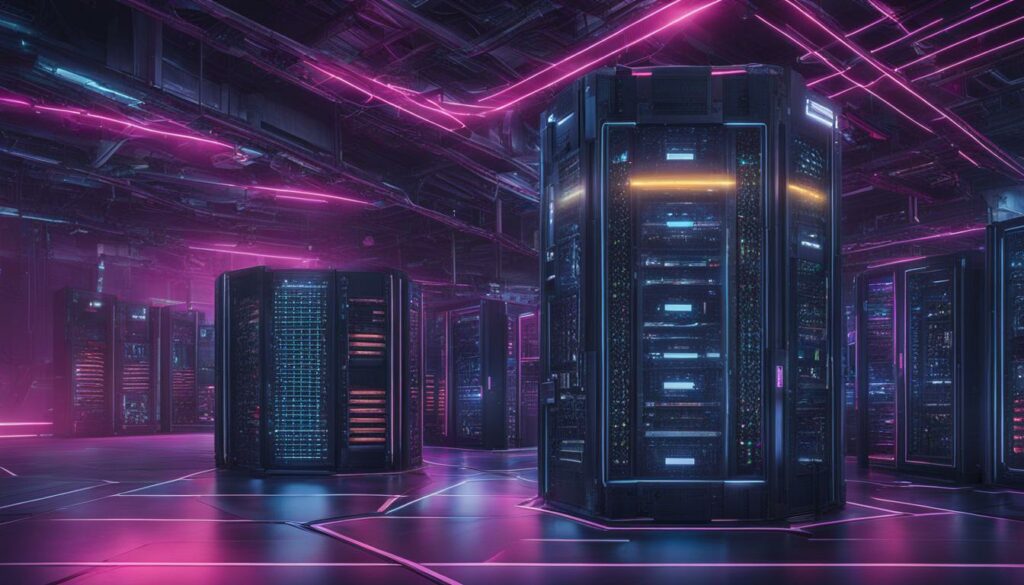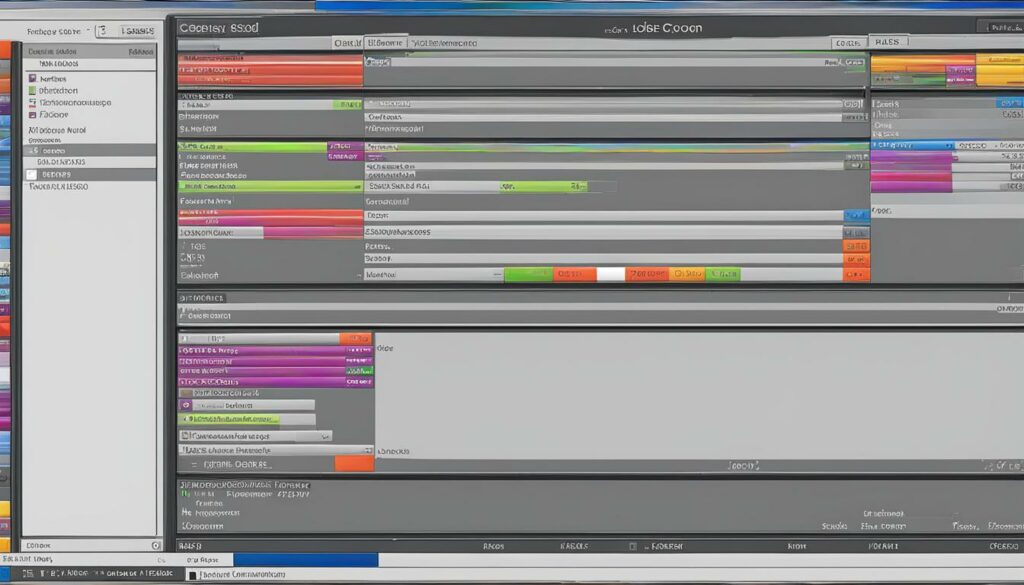Welcome to our comprehensive guide on green and eco-friendly web hosting. In today’s digitally-driven world, it’s crucial to consider the environmental impact of our online activities. Did you know that the internet is responsible for 2% of global greenhouse gas emissions? That’s equivalent to the entire country of Germany. Sustainable web development offers a solution to combat climate change and create a greener internet.
Green web hosting, also known as eco-friendly web hosting, focuses on minimizing the environmental footprint of websites. By choosing a hosting service that prioritizes sustainability, you can contribute to a more eco-conscious online presence. But the benefits don’t stop there. Green hosting also brings social and economic advantages, creating a win-win situation for businesses and the planet.
Key Takeaways:
- Green web hosting is essential for combatting global warming and reducing the environmental impact of the internet.
- Choosing sustainable web development practices can improve a brand’s reputation and attract eco-conscious customers.
- Optimizing images is a crucial step in creating sustainable websites, reducing energy consumption and enhancing performance.
- When selecting a hosting service, consider providers that rely on renewable energy sources to minimize carbon emissions.
- Reducing server calls and implementing lazy loading and CSS sprites are effective ways to optimize websites for energy efficiency.
The Impact of Traditional Web Hosting on the Environment
Traditional web hosting services have a significant impact on the environment, contributing to global warming and depleting valuable resources. By understanding the environmental consequences of these services, you can make informed decisions that benefit both your business and the planet.
Global warming is a pressing issue that affects us all. The energy consumption associated with traditional web hosting releases greenhouse gases into the atmosphere, contributing to climate change. This not only poses long-term risks to our environment but also threatens the well-being of future generations.
Furthermore, traditional web hosting relies on non-renewable resources such as coal and natural gas. These resources are finite and their extraction often leads to environmental degradation and habitat destruction. By continuing to rely on traditional hosting services, we contribute to resource depletion and disrupt delicate ecosystems.
On the other hand, sustainable web hosting offers a more cost-efficient solution. By utilizing renewable energy sources such as wind or solar power, sustainable hosting providers reduce their carbon footprint and operational costs. This results in long-term savings for businesses and a positive impact on the environment.
Choosing sustainable hosting options also enhances your brand’s reputation and fosters customer trust. In an era where consumers are increasingly conscious of their environmental impact, demonstrating your commitment to sustainability can differentiate your business from competitors and attract environmentally-minded customers.
Moreover, sustainable web development practices align with search engine optimization (SEO) principles. The emphasis on efficient resource utilization and clean energy can contribute to improved SEO rankings. Search engines prioritize websites that offer fast loading times, relevant content, and a positive user experience, all of which can be achieved through sustainable web development.
By adopting sustainable web hosting practices, businesses can achieve the “Triple Bottom Line” – a framework that emphasizes the social, environmental, and economic benefits of sustainable development. By considering these three aspects, we can create a more sustainable future for both our businesses and the planet.
| Traditional Web Hosting | Sustainable Web Hosting |
|---|---|
| Contributes to global warming | Reduces carbon footprint |
| Depletes valuable resources | Utilizes renewable energy |
| Inefficient energy utilization | Cost-efficient energy usage |
| Potential harm to brand reputation | Builds customer trust |
| Limited SEO advantages | Improved SEO rankings |
The table above highlights the key differences between traditional web hosting and sustainable web hosting. These factors illustrate the advantages and positive impact that sustainable practices can have on your business, the environment, and your online presence.
Optimizing Images for Sustainability
Large image files can significantly impact the speed and energy consumption of your website. To make your website more sustainable, it is essential to optimize images without compromising their quality. This can be achieved through image compression techniques.
Image compression reduces the file size of images, making them smaller and easier to load. By compressing images, you can improve website performance, reduce bandwidth usage, and minimize the carbon footprint of your website. This step is crucial in sustainable web design.
There are various tools available that can help you optimize image files efficiently:
- ImageOptim: This tool supports various image formats and uses advanced compression algorithms to reduce file sizes while maintaining image quality. It is available for both Mac and Windows operating systems.
- TinyPNG: This online tool allows you to compress PNG and JPEG images without compromising their visual integrity. It employs smart lossy compression techniques to reduce file sizes while preserving image details.
By utilizing these tools, you can ensure that your website’s images are optimized for sustainability, delivering a better user experience while minimizing environmental impact.
Optimized images not only contribute to the sustainable web design but also enhance user experience and improve website performance. With the right image compression tools, you can strike a balance between visual appeal and environmental responsibility.
Remember, sustainable web design is not just about reducing energy consumption but also making conscious choices throughout the design and development process to minimize the overall environmental impact. Optimizing images is a significant step towards achieving this goal.
| Image Compression Tools | Features |
|---|---|
| ImageOptim | Supports various image formats and uses advanced compression algorithms |
| TinyPNG | Compresses PNG and JPEG images without compromising visual integrity |

Choosing Green Hosting Services
When it comes to hosting your website, it’s essential to consider the environmental impact. Traditional hosting services rely on fossil fuels, which contribute to carbon emissions and harm the planet. But there’s a better alternative – green hosting.
Green hosting services, like Google Cloud Platform and GreenGeeks, prioritize sustainable practices and use renewable energy sources to power their servers. By opting for green hosting, you can significantly reduce your website’s carbon footprint and contribute to a greener future.
Not only does green hosting help preserve the environment, but it also aligns with the values of eco-conscious consumers. Sustainability has become a significant selling point for businesses, attracting customers who are passionate about reducing their environmental impact.
“Green hosting not only helps preserve the environment but also aligns with the values of eco-conscious consumers.”
Make a positive difference by choosing green hosting for your website. Take a step towards a sustainable future.
Comparison of Green Hosting Services
| Hosting Provider | Renewable Energy | Carbon Neutral |
|---|---|---|
| Google Cloud Platform | 100% | Yes |
| GreenGeeks | 300% | Yes |
Note: The data in the table represents the percentage of renewable energy used by each hosting provider and indicates whether they are carbon neutral.
By comparing different green hosting services, you can choose the one that best suits your needs and values. Consider factors such as uptime, customer support, and pricing alongside their commitment to renewable energy.
With green hosting, not only will you have a reliable website, but you’ll also be actively contributing to a more sustainable internet. Make the switch today and reduce your website’s environmental impact.
Reducing Energy Consumption through Optimization
When it comes to creating a sustainable website, every decision matters. One key factor to consider is the energy consumption of your site. Each server call requires energy, and by reducing the number of server calls, you can effectively lower your website’s energy consumption and minimize its environmental impact.
Optimizing your website to reduce server calls can be achieved through various strategies and tools. One such tool is Google Developer Tools, which provides insights into your website’s performance and suggests optimizations for reducing server requests.
Another way to minimize server calls is by minimizing the use of plugins and external scripts. These additional elements often require separate server requests, increasing energy consumption. By limiting the number of plugins and scripts, you can streamline your website’s performance and decrease its carbon footprint.
Implementing Google Developer Tools for Optimization
To optimize your website and reduce server calls, follow these steps:
- Access Google Developer Tools by opening the Google Chrome browser and clicking on the three-dot menu in the top right corner. From the dropdown menu, select “More Tools” and then “Developer Tools”.
- In the Developer Tools panel, click on the “Network” tab.
- Reload your website by pressing the refresh button or using the keyboard shortcut (Ctrl + R).
- Observe the requests made by your website in the Network panel. Identify any unnecessary calls or resources that can be optimized or removed.
- Implement the suggested optimizations, such as reducing the size of images or combining multiple requests into one.
- Regularly monitor your website’s performance using Google Developer Tools and continue optimizing to maintain energy efficiency.
By adopting these optimization practices, you can significantly reduce energy consumption and make your website more sustainable.
“Reducing server calls not only benefits the environment but also improves website performance and user experience. Embracing optimization is a win-win situation.”
– John Green, Sustainable Web Developer

| Website Optimization | Impact on Energy Consumption |
|---|---|
| Reducing server calls | Significantly lowers energy consumption |
| Minimizing plugins and external scripts | Decreases energy usage by reducing unnecessary requests |
Implementing Lazy Loading for Energy Efficiency
When it comes to creating a sustainable website, one technique you should consider is lazy loading. This approach delays the loading of images and media files that aren’t immediately visible on the screen. By doing so, it reduces the initial energy consumption required to load the entire web page.
To implement lazy loading on your website, you can leverage JavaScript libraries like Lozad.js. This library allows you to easily apply lazy loading functionality to your images and other media elements. By utilizing the lazy loading technique, you contribute to energy efficiency and promote a more sustainable web design.

Lazy loading not only reduces energy consumption, but it also enhances user experience by improving page load times. With lazy loading, visitors will experience faster initial page renderings, leading to a smoother and more enjoyable browsing experience.
By incorporating lazy loading into your sustainable web design strategy, you can significantly minimize the environmental impact of your website and contribute to creating a greener internet.
Using CSS Sprites for Speed and Energy Efficiency
When it comes to sustainable web development, CSS sprites are a game-changer. By combining multiple images into a single file, CSS sprites reduce the number of HTTP requests and conserve energy needed to fetch the files. This technique not only improves website speed but also contributes to energy efficiency, making it a win-win situation.
“CSS Sprites: Enhancing website performance and reducing energy consumption.”
With CSS sprites, you can minimize the need for separate image files and save valuable server resources. Instead of making individual requests for each image, the browser only needs to fetch one file, resulting in faster loading times and smoother user experiences.
Not only does this optimization technique improve website performance, but it also reduces the amount of energy consumed during the loading process. By minimizing the number of HTTP requests, the server’s workload is lightened, leading to lower energy consumption and a more sustainable web presence.
Benefits of CSS Sprites:
- Speed: By reducing the number of HTTP requests, CSS sprites significantly improve website speed, resulting in better user experiences.
- Energy Efficiency: Minimizing server workload decreases energy consumption, contributing to sustainable web development.
- Resource Optimization: Combining multiple images into one file conserves server resources, optimizing performance and reducing the strain on the server.
Incorporating CSS sprites into your web development workflow is relatively simple. By following best practices and utilizing tools like SpriteMe or Compass, you can create efficient and visually appealing sprites for your website.
To better understand the benefits of CSS sprites and their impact on website speed and energy efficiency, take a look at the following example:
| Without CSS Sprites | With CSS Sprites |
|---|---|
In this example, the left column represents a web page without CSS sprites, with multiple image files making separate HTTP requests. Conversely, the right column showcases the same web page, but with CSS sprites implemented. Notice how only one image file needs to be fetched, resulting in a faster and more energy-efficient loading process.
By incorporating CSS sprites into your web development strategies, you can significantly enhance website speed and contribute to sustainable web development. The positive impact on user experiences and the environment makes CSS sprites an essential optimization technique for the modern web.
Conclusion
Sustainable web development is more than just an ethical choice – it’s a smart business decision. By implementing eco-friendly practices, you can optimize your website’s performance, reduce its environmental impact, and attract eco-conscious consumers.
Optimizing images is a crucial step in creating an eco-friendly website. By compressing image files without compromising quality, you can significantly reduce your website’s energy consumption and load times. Tools like ImageOptim and TinyPNG make this process simple and effective.
In addition to image optimization, choosing green hosting services is another important aspect of sustainable web development. Green hosting providers leverage renewable energy sources, minimizing the carbon footprint associated with website hosting. Companies like Google Cloud Platform and GreenGeeks are leading the way in eco-friendly hosting solutions.
Reducing energy consumption through various optimization techniques is also key to sustainable web development. By minimizing server calls, optimizing website code, and implementing lazy loading and CSS sprites, you can significantly improve your website’s energy efficiency and overall performance.
Regular monitoring and continuous efforts towards sustainability are essential. By embracing sustainable web development practices, you can not only contribute to creating a greener internet but also enhance your brand’s reputation and attract environmentally conscious users.
FAQ
Q: What is green web hosting?
A: Green web hosting refers to hosting services that use renewable energy sources, such as solar or wind power, to power their servers. By opting for green web hosting, you can reduce your website’s carbon footprint and support sustainability efforts.
Q: Why is sustainable web development important?
A: Sustainable web development is crucial to combat climate change. The internet is responsible for 2% of global greenhouse gas emissions, equivalent to the entire country of Germany. By adopting sustainable practices, such as optimizing images and reducing server calls, you can contribute to a greener internet.
Q: What are the benefits of green web hosting?
A: Green web hosting offers environmental, social, and economic benefits. By choosing a green hosting service, you can reduce your website’s carbon emissions, enhance your brand’s reputation, and improve your SEO rankings. Additionally, green hosting can be a selling point for eco-conscious consumers.
Q: How can I optimize images for sustainability?
A: Compressing images without sacrificing quality is a crucial step in making a website sustainable. Tools like ImageOptim and TinyPNG can help optimize image files, reducing their size and minimizing energy consumption.
Q: Which hosting services use renewable energy sources?
A: Green hosting services like Google Cloud Platform and GreenGeeks utilize renewable energy sources, such as solar and wind power, to power their servers. By choosing these services, you can reduce your website’s carbon footprint and support sustainable practices.
Q: How can I reduce energy consumption through optimization?
A: Each server call consumes energy, so reducing them can lower a website’s energy consumption. You can optimize your website to reduce server calls using tools like Google Developer Tools. Additionally, minimizing plugins and external scripts contributes to a more sustainable website.
Q: What is lazy loading and how does it improve energy efficiency?
A: Lazy loading is a technique that delays the loading of images and media that aren’t immediately visible on the screen. By implementing lazy loading, you can reduce initial energy consumption and improve website performance. JavaScript libraries like Lozad.js can be used to implement lazy loading.
Q: What are CSS sprites and how do they improve energy efficiency?
A: CSS sprites combine multiple images into a single file, reducing the number of HTTP requests and energy needed to fetch the files. By using CSS sprites, you can improve website speed and energy efficiency, contributing to a more sustainable web development.
Q: Why is sustainable web development a smart business decision?
A: Sustainable web development not only aligns with ethical values but also offers immediate and long-term benefits for businesses. Optimizing images, choosing green hosting, and reducing energy consumption can enhance a brand’s reputation, improve SEO rankings, and lead to better operational performance and financial returns. Regular monitoring and continuous efforts towards sustainability are essential to create a greener internet.












